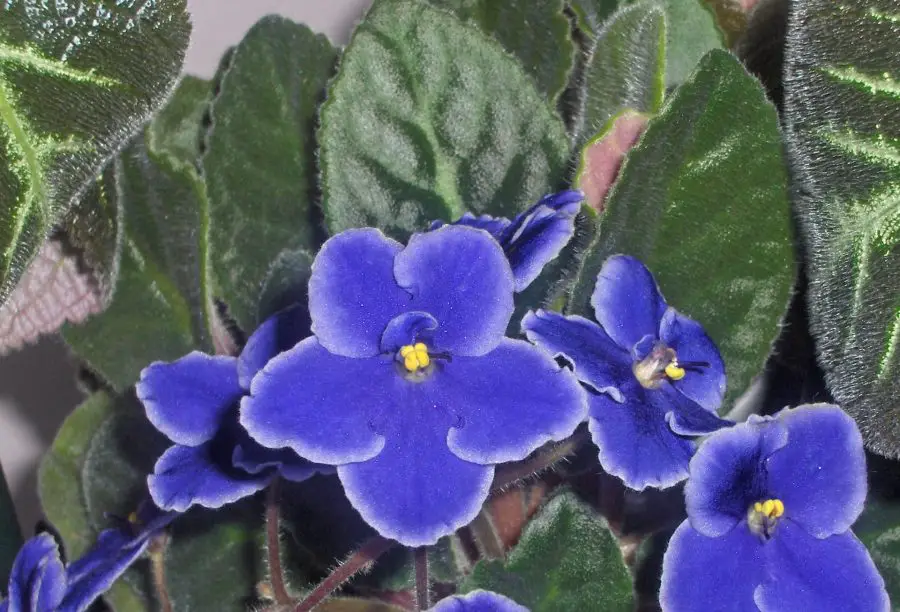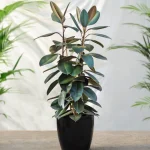This post contains affiliate links. If you buy something from one of our links we may earn a commission. Thanks

Discover the secrets to thriving African Violet Care Indoors with our comprehensive guide! Uncover tips & tricks for light, soil, watering, and more.
African Violet Care Indoors involves providing bright, indirect light and maintaining high humidity. Water the plant when the soil is slightly dry to the touch, using lukewarm water to avoid leaf spots. Fertilize every 4-6 weeks with a balanced, water-soluble fertilizer designed for flowering plants. Avoid getting water on the leaves to prevent spotting.
Welcome to the vibrant world of African Violet Care Indoors!
These charming, colorful plants are the perfect addition to brighten up any space, and with our comprehensive guide, you’ll soon become an expert in creating a cozy, indoor haven for your African Violets.
Whether you’re a seasoned green thumb or just starting your journey, join us as we explore the ins and outs of nurturing these lovely plants to help them flourish in the comfort of your home.
African Violet Care Indoors: A Comprehensive Guide
Welcome, fellow plant enthusiasts, to our all-inclusive guide on African Violet Care Indoors!
If you’re looking to add a touch of elegance and color to your home, African Violets are just the ticket.
In this comprehensive guide, we’ll dive deep into the world of these delightful indoor plants, covering everything from light requirements to troubleshooting common issues.
Whether you’re a first-time owner or a seasoned African Violet caretaker, this guide is your one-stop resource for helping your lovely blooms thrive.
So, let’s embark on this blooming adventure together!
The Allure of African Violets
Delicate and vibrant, African Violets (saintpaulia ionantha) have been a popular choice among houseplant enthusiasts for decades.
Originally from Eastern Africa, these beauties boast a wide range of colors, including shades of purple, blue, pink, and white.
The velvety leaves and stunning blooms can brighten up any indoor space, making them an irresistible addition to your plant collection.
Embracing Indoor Care for African Violets
While African Violets may appear dainty, they are resilient plants that can thrive indoors when given proper care.
Due to their tropical origins, these plants prefer a cozy, controlled environment that mimics their natural habitat.
Providing the right balance of light, temperature, and humidity is crucial to keeping your African Violets healthy and happy.
In this guide, we’ll explore all the essential aspects of indoor care to help you cultivate flourishing African Violets right in your own home.
How to Care for African Violets Indoors
Ready to embark on the rewarding journey of African Violet care indoors? You’re in the right place!
In this section, we’ll delve into the details of nurturing these captivating houseplants and uncover the secrets to a thriving indoor garden.
From creating the perfect environment to mastering the art of propagation, we’ll equip you with all the knowledge you need to keep your African Violets flourishing.
So, whether you’re just beginning your plant parenting journey or have a houseful of verdant companions, let’s dive in and discover the joys of African Violet care together!
Perks of Cultivating African Violets Indoors
Choosing to grow African Violets indoors comes with a myriad of benefits.
Not only do these eye-catching plants add a pop of color to your living space, but they also act as natural air purifiers, helping to filter out pollutants and improve indoor air quality.
Additionally, tending to your African Violets can be a therapeutic activity, providing a sense of accomplishment and promoting mindfulness as you nurture your plants.
Building the Perfect Indoor Haven for African Violets
To ensure your African Violets thrive indoors, it’s crucial to recreate their natural habitat by providing the right conditions.
This involves regulating temperature, humidity, and light, as well as choosing the appropriate soil, pot, and watering routine.
In the following sections, we’ll guide you through each aspect of creating the ideal environment for your African Violets, ensuring they remain healthy and vibrant throughout the year.
African Violet Light Requirements
Let’s talk about light – a crucial ingredient for happy and healthy African Violets!
In this section, we’ll explore the ins and outs of their lighting preferences, ensuring your indoor beauties receive just the right amount of sunshine.
We’ll cover everything from the type of light they love to the best practices for providing optimal light conditions.
So, whether you’re blessed with abundant natural light or need to rely on artificial sources, we’ll help you shine the perfect light on your African Violets and watch them flourish!
Exploring Light Types for African Violets
When it comes to lighting, African Violets are a bit particular. They prefer bright, indirect light, as direct sunlight can scorch their delicate leaves.
While natural light from an east or north-facing window is ideal, you can also rely on artificial sources like a fluorescent or LED grow light to provide enough light.
Perfecting Light Exposure for Happy Violets
Striking the right balance between duration and intensity of light exposure is crucial for your African Violets.
Aim for about 10-12 hours of bright, indirect light per day, followed by a period of darkness to mimic their natural environment.
Keep in mind that too little light may result in leggy growth and fewer blooms, while too much sunlight can cause leaf burn or discoloration.
Illuminating Tips for Healthy African Violets
To provide optimal light conditions for your African Violets, consider these helpful tips:
1. Place your plants near an east or north-facing window that receives bright, indirect light.
2. If natural light is insufficient, invest in fluorescent lights or LED grow lights to supplement their lighting needs.
3. Rotate your plants every few weeks to ensure even light distribution and prevent lopsided growth.
4. Adjust the distance between your plants and light source to prevent overexposure or underexposure, keeping an eye out for signs of distress.
Using sheer curtains for a south-facing window
Utilizing sheer curtains for a south-facing window can be an excellent solution to provide your African Violets with the indirect bright light they crave.
South-facing windows typically receive strong sunlight throughout the day, which may be too harsh for these delicate plants.
By hanging sheer curtains, you can effectively diffuse the sunlight, creating a softer, more evenly distributed light that’s just perfect for your African Violets.
Remember to monitor your plants for any signs of distress, such as leaf scorch or discoloration, which may indicate a need to adjust their position or the curtain’s opacity.
With some careful observation and fine-tuning, your south-facing window can become a haven for your flourishing African Violets.
Temperature And Humidity
The best temperature for African Violets is between 65-75°F (18-24°C) during the day, with slightly cooler temperatures at night.
They can tolerate a slightly wider temperature range, but extremes should be avoided as they can cause stress to the plant.
As for humidity, African Violets thrive in a moderately humid environment, with relative humidity levels between 40-60%. Maintaining proper humidity is essential for their growth and flowering.
You can increase humidity around the plant by using a humidity tray, misting the area around the plant (avoid misting the leaves directly), or placing a humidifier nearby.
Remember to monitor the humidity levels to prevent issues related to overly dry or high humidity conditions.
African Violet Pots
Now that we’ve shed some light on your African Violets, let’s discuss their next essential need: pots!
The right pot can make all the difference in keeping your violets happy and thriving.
In this section, we’ll dive into the world of African Violet pots, exploring the best materials, sizes, and features to support your plant’s growth.
So, whether you’re repotting a mature plant or potting a new cutting, let’s embark on this journey to find the perfect home for your African Violets!
Picking the Perfect Pot: Size and Material
When it comes to selecting the ideal pot for your African Violets, both size and material play crucial roles.
African Violets prefer snug pots, so choose one that’s just slightly larger than the root ball.
As for material, consider using plastic, ceramic, or glazed pots. Each has its pros and cons – plastic pots are lightweight and inexpensive, while ceramic and glazed pots retain moisture longer and add a decorative touch.
Don’t Forget the Drainage
Proper drainage is essential for African Violets to prevent root rot and maintain healthy growth.
Make sure your chosen pot has drainage holes in the bottom of the pot to allow excess water to escape.
You can also use a saucer to catch any runoff and protect your surfaces. Remember to empty the saucer after watering to prevent your plant from sitting in standing water.
The Magic of Self-Watering Pots
Self-watering pots can be a game-changer for African Violet care.
These innovative containers feature a reservoir at the bottom that holds water, allowing the plant to absorb moisture as needed through a wicking system.
This can help maintain consistent soil moisture levels, reducing the risk of overwatering or underwatering your African Violets.
If you decide to give self-watering pots a try, just remember to monitor the reservoir and refill it as needed to keep your plants happy and hydrated.
African Violet Soil
Let’s get down and dirty with one of the most important aspects of African Violet care, the soil!
A well-formulated soil mix is the foundation for a thriving plant, providing the nutrients, aeration, and moisture retention they need.
In this section, we’ll delve into the benefits of using coco coir and perlite over traditional peat-based mixes, ensuring your African Violets have the best possible growing medium.
So, grab your gardening gloves, and let’s learn how to create the ultimate soil mix for your gorgeous African Violets!
Crafting the Perfect Soil Composition
The ideal soil mix for African Violets should be light, airy, and well-draining, providing the right balance of nutrients and moisture.
We recommend using a blend of coco coir and perlite over traditional peat-based mixes.
Coco coir is an excellent choice due to its sustainability, water retention, and aeration properties.
Perlite, on the other hand, improves drainage and prevents soil compaction, ensuring your African Violets’ roots have room to breathe and grow.
Mixing Your Own African Violet Soil
To create your custom soil mix, combine equal parts of coco coir and perlite.
You can also add a small portion of vermiculite to further enhance water retention and nutrient availability.
Thoroughly mix the ingredients to ensure a uniform blend, and moisten it slightly before potting your African Violets.
This soil mix will provide your plants with the ideal growing environment, promoting healthy root systems and vibrant blooms.
Nurturing Healthy Soil for Happy Violets
Maintaining healthy soil is crucial for the well-being of your African Violets. Keep these tips in mind to ensure your soil stays in top condition:
1. Monitor soil moisture levels, taking care to avoid overwatering or underwatering.
2. Refresh the soil mix during repotting or if you notice signs of nutrient deficiency.
3. Ensure proper drainage to prevent waterlogged soil and root rot.
4. Fertilize your African Violets regularly with a balanced fertilizer to replenish nutrients in the soil.
How to Water African Violets
Watering may seem like a simple task, but when it comes to African Violets, there’s more to it than meets the eye!
In this section, we’ll share the secrets to keeping your violets hydrated and happy, with tips on frequency, technique, and even water temperature.
We know that watering can sometimes feel like a guessing game, but with our guidance, you’ll become a master of African Violet hydration in no time!
So, let’s dive in and learn the art of watering these delicate beauties.
Mastering African Violet Watering Techniques
To keep your African Violets thriving, it’s essential to employ the proper watering techniques.
For best results, these plants prefer to be watered from the bottom to avoid getting their fuzzy leaves wet, which can lead to spotting or rot.
Simply place your potted violet in a saucer filled with room-temperature water and let the plant absorb the moisture for about 30 minutes.
Alternatively, you can use a self-watering pot to ensure a consistent water supply.
Always use room temperature water and avoid using cold water as it can shock your plants.
Knowing When to Water
Determining when to water your African Violets is crucial to maintain healthy growth.
The best approach is to allow the top inch of the soil to dry out between watering sessions.
You can check the moisture level by gently pressing your finger into the soil or using a moisture meter.
Keep in mind that factors like temperature, humidity, and light conditions can affect how quickly the soil dries out, so adjust your watering schedule accordingly.
Steering Clear of Watering Mistakes
Avoiding common watering pitfalls can help keep your African Violets healthy and happy.
Overwatering can lead to root rot, while underwatering may cause wilting and poor growth.
To prevent these issues, stick to a consistent watering schedule based on your plant’s specific needs, and always ensure proper drainage to avoid waterlogged soil.
The Trouble with Tap Water
Tap water can sometimes pose problems for African Violets due to its varying mineral content and the potential presence of chlorine or fluoride.
These additives can harm your plants or cause unsightly mineral buildup in the soil.
To avoid these issues, consider using filtered, distilled, or rainwater for your African Violets.
African Violet Fertilizer
Just like us, African Violets need a little nourishment to keep them looking their best!
In this section, we’ll explore the world of African Violet fertilizers, discussing the best formulations, application methods, and schedules to help your plants grow and bloom to their fullest potential.
With a little bit of guidance and the right nutrients, you’ll be amazed at how your African Violets flourish.
So, let’s dive into the essential details of feeding these gorgeous plants and watch them thrive!
Nourishing Choices: Fertilizers for African Violets
To keep your African Violets well-fed, opt for a balanced, water-soluble fertilizer specifically formulated for these plants.
Look for a fertilizer with an equal ratio of nitrogen, phosphorus, and potassium (e.g., 10-10-10 or 20-20-20).
Some specialty African Violet fertilizers also contain essential micronutrients, which further support healthy growth and blooming.
Feeding Your Violets: Application and Frequency
Proper application and frequency are key to successfully fertilizing your African Violets.
Follow the manufacturer’s instructions for mixing the fertilizer with water, and apply it to the soil when you water your plants.
It’s generally recommended to fertilize African Violets every 4-6 weeks, but some growers prefer a “weakly, weekly” approach, using a diluted fertilizer solution each time they water.
You can fertilize less often during the winter months when the plants aren’t growing actively.
Adjust your fertilizing schedule based on your plants’ growth and response.
Over-Fertilization Woes and Remedies
Over-fertilization can cause various problems for your African Violets, such as leaf burn, reduced flowering, or root damage.
Signs of over-fertilization include yellowing leaves, a white crust on the soil surface, or wilting despite adequate watering.
To correct over-fertilization, flush the soil with clean water to remove excess salts and nutrients, and reduce your fertilizing frequency or strength.
Keep an eye on your plants and adjust your fertilizing practices as needed to maintain their health and vitality.
African Violet Repotting
Even the most stunning African Violets can outgrow their homes from time to time!
In this section, we’ll explore the ins and outs of repotting your African Violets, discussing the best techniques, ideal timing, and crucial tips to ensure a smooth transition for your beloved plants.
With our guidance, you’ll be able to provide your African Violets with the room they need to grow, maintaining their health and beauty for years to come.
So, let’s dive in and learn the secrets to successful African Violet repotting!
A. Repotting Radar: When It’s Time for a Change
Knowing when to repot your African Violet is crucial for maintaining its health and vigor.
Generally, you should repot your plant every 6-12 months, or when you notice signs that it has outgrown its current pot.
These signs may include roots growing out of the drainage holes, tightly packed soil, or the plant becoming top-heavy and unstable.
The African Violet Repotting Process, Step by Step
Follow these steps for a smooth repotting experience:
1. Choose a pot that’s slightly larger than the current one, ensuring it has drainage holes.
2. Prepare your soil mix, combining equal parts of coco coir and perlite (or using a premixed African Violet blend).
3. Gently remove the plant from its current pot, taking care not to damage the roots.
4. Trim any dead or damaged roots and remove any excess soil.
5. Place a layer of the new soil mix in the bottom of the new pot.
6. Position your African Violet in the pot, ensuring the crown sits slightly above the soil line.
7. Fill in the gaps around the roots with more soil mix, pressing gently to eliminate air pockets.
8. Water the plant thoroughly and place it in its usual growing spot.
Repotting Tips for Happy African Violets
To ensure a successful repotting, keep these tips in mind:
1. Repot your African Violets during their active growing period, typically in spring or summer.
2. Be gentle with the roots to minimize stress and potential damage.
3. Avoid overpacking the soil, as this can reduce aeration and drainage.
How to Propagate African Violets
What’s better than one beautiful African Violet? Several of them, of course!
In this section, we’ll uncover the magic of propagating African Violets, teaching you how to create new plants from your existing beauties.
With our easy-to-follow guide, you’ll soon be sharing the joy of these stunning plants with friends and family, or simply expanding your own collection.
So, let’s dive into the fascinating world of African Violet propagation and learn how to multiply your floral treasures!
Choosing Your Path: African Violet Propagation Methods
There are several methods for propagating African Violets, but the most popular and successful one is leaf cuttings.
This method involves taking a healthy leaf from the parent plant, along with a portion of its stem, and rooting it in a suitable growing medium.
Other methods include division and tissue culture, but these are less commonly used due to their complexity.
Growing New Violets: Steps for Successful Propagation
Follow these steps to propagate African Violets using leaf cuttings:
1. Select a healthy, mature leaf from the parent plant, preferably one from the second row of leaves.
2. Cut the leaf stem at a 45-degree angle, leaving about 1-1.5 inches of stem attached to the leaf.
3. Fill a small pot or container with a well-draining soil mix, such as a blend of coco coir and perlite.
4. Dip the cut end of the stem into rooting hormone (optional), and then insert it into the soil mix.
5. Water the soil gently, ensuring it’s moist but not waterlogged.
6. Cover the pot with a clear plastic bag or place it in a propagator to maintain humidity.
7. Place the pot in a warm, brightly lit area, out of direct sunlight.
Tender Loving Care: Nurturing New African Violet Plants
Once your leaf cutting has taken root and produced baby plants (typically after 8-12 weeks), follow these steps to care for your new African Violets:
1. Gently separate the baby plants from the mother leaf, ensuring each has a healthy root system.
2. Pot each baby plant in its own small pot, using the same soil mix as for the leaf cutting.
3. Water the newly potted plants and place them in a brightly lit location, away from direct sunlight.
4. Gradually acclimate the new plants to the same care routine as your mature African Violets, including watering, fertilizing, and light exposure.
Choosing Your Path: African Violet Propagation Methods
There are several methods for propagating African Violets, but the most popular and successful one is leaf cuttings.
This method involves taking a healthy leaf from the parent plant, along with a portion of its stem, and rooting it in a suitable growing medium.
Other methods include division and tissue culture, but these are less commonly used due to their complexity.
Growing New Violets: Steps for Successful Propagation
Follow these steps to propagate African Violets using leaf cuttings:
1. Select a healthy, mature leaf from the parent plant, preferably one from the second row of leaves.
2. Cut the leaf stem at a 45-degree angle, leaving about 1-1.5 inches of stem attached to the leaf.
3. Fill a small pot or container with a well-draining soil mix, such as a blend of coco coir and perlite.
4. Dip the cut end of the stem into rooting hormone (optional), and then insert it into the soil mix.
5. Water the soil gently, ensuring it’s moist but not waterlogged.
6. Cover the pot with a clear plastic bag or place it in a propagator to maintain humidity.
7. Place the pot in a warm, brightly lit area, out of direct sunlight.
Tender Loving Care: Nurturing New African Violet Plants
Once your leaf cutting has taken root and produced baby plants (typically after 8-12 weeks), follow these steps to care for your new African Violets:
1. Gently separate the baby plants from the mother leaf, ensuring each has a healthy root system.
2. Pot each baby plant in its own small pot, using the same soil mix as for the leaf cutting.
3. Water the newly potted plants and place them in a brightly lit location, away from direct sunlight.
4. Gradually acclimate the new plants to the same care routine as your mature African Violets, including watering, fertilizing, and light exposure.
Can you use division?
You can use division as a propagation method for African Violets, especially when repotting.
Division is best suited for mature plants that have developed multiple crowns, which are the central growing points from which the leaves and flowers emerge.
Here’s how to propagate African Violets through division during repotting:
Carefully remove the African Violet from its current pot, gently shaking off excess soil to expose the root system.
Inspect the plant to identify individual crowns with their own root systems. Look for natural separations between the crowns, as this will make dividing the plant easier.
Using clean, sharp scissors or a knife, cut through the roots to separate the crowns. Be careful not to damage the root systems, and ensure each division has a healthy portion of roots attached.
Prepare new pots with a well-draining soil mix, such as a blend of coco coir and perlite.
Plant each division in its own pot, ensuring the crown sits slightly above the soil line.
Water the newly potted divisions thoroughly and place them in a brightly lit location, away from direct sunlight.
Care for the divisions as you would mature African Violets, following the same watering, fertilizing, and light exposure routines.
Keep in mind that the division method might be slightly more stressful for the plant compared to leaf cuttings, but it can still be a successful way to propagate African Violets when done carefully.
How Often Do African Violets Bloom
African Violets are adored for their vibrant, long-lasting blooms, but just how often can you expect these beauties to put on a floral show?
In this section, we’ll delve into the blooming habits of African Violets, discussing factors that influence their flowering frequency and how you can encourage your plants to bloom more often.
By understanding the secrets to a bountiful display, you’ll be able to enjoy your African Violets’ stunning colors and delicate blossoms even more frequently.
So, let’s get ready to unlock the full potential of your African Violets’ blooming prowess!
Blooming Behavior: Factors Affecting African Violet Flowering Frequency
Several factors influence how often your African Violets will bloom, including light exposure, temperature, fertilization, and overall plant health.
In optimal conditions, these lovely plants can bloom almost continuously, taking short breaks between flowering cycles.
However, it’s more common for African Violets to bloom every few months, with each cycle lasting several weeks.
Bloom Boosters: Tips for Encouraging African Violet Blooms
To increase the chances of your African Violets blooming more frequently, follow these tips:
1. Provide adequate light: Ensure your African Violets receive bright, indirect light for at least 10-12 hours per day. A well-lit environment is essential for flowering.
2. Maintain proper temperature: Keep your plants in a room with temperatures between 65-75°F (18-24°C) during the day and slightly cooler at night. Avoid sudden temperature fluctuations, which can inhibit blooming.
3. Fertilize appropriately: Use a balanced, water-soluble fertilizer specifically formulated for African Violets, and follow the recommended application rates and frequency. Proper nutrition is key to promoting blooms.
4. Ensure good plant health: Healthy African Violets are more likely to bloom. Monitor your plants for pests or diseases and address any issues promptly.
Regularly remove dead or damaged leaves and spent flowers to encourage new growth and blooms.
Deadheading
Deadheading is the process of removing spent flowers from a plant to promote healthier growth, maintain its appearance, and, in some cases, encourage further blooming.
For African Violets, deadheading can be beneficial in maintaining the plant’s overall health and appearance. Here’s how to deadhead your African Violets:
Inspect your African Violet regularly for spent flowers that have wilted, faded, or dried up.
It’s best to remove them as soon as you notice them to keep the plant looking tidy.
Using clean, sharp scissors or your fingers, carefully snip or pinch off the spent flower at its base, where it connects to the main stem.
Be gentle to avoid damaging the surrounding leaves or healthy blossoms. This is also a good time to remove any dead leaves.
Dispose of the removed flowers properly to prevent any potential disease or pest issues.
While deadheading African Violets might not directly stimulate new blooms as it does in some other flowering plants, it can help to redirect the plant’s energy towards producing new growth and maintaining overall health, which can contribute to more frequent blooming cycles.
How Do I Get My African Violet to Bloom Again
Have your African Violets stopped blooming, leaving you longing for their gorgeous blossoms?
Don’t worry, we’ve got you covered! In this section, we’ll share some tried-and-true tips on reviving your African Violet’s flowering potential.
We’ll explore the common reasons why these stunning plants might take a break from blooming and guide you through the steps to help them regain their floral glory.
So, let’s work together to bring back those enchanting blooms and fill your indoor garden with color and charm once again!
Blooming Blues: Identifying Reasons for Lack of African Violet Blooming
Before addressing the issue, it’s essential to identify the factors that may be causing your African Violet to stop blooming.
Some common reasons include insufficient light, improper watering, inadequate fertilization, or the plant being potbound.
Blooming Revival: Steps to Stimulate African Violet Blooming
To help your African Violet bloom again, follow these steps:
1. Ensure optimal light exposure: Provide bright, indirect light for at least 10-12 hours per day. If natural light isn’t sufficient, consider supplementing with artificial light sources.
2. Water correctly: Avoid over- or under-watering your plant. Water when the top inch of the soil feels dry, using room-temperature water. Consider bottom-watering to prevent crown rot.
3. Fertilize properly: Use a balanced, water-soluble fertilizer specifically formulated for African Violets. Follow the recommended application rates and frequency.
4. Repot if necessary: If your plant is potbound, consider repotting it into a slightly larger pot with fresh soil to encourage new growth and blooms.
5. Maintain proper temperature: Keep your African Violets in a room with temperatures between 65-75°F (18-24°C) during the day and slightly cooler at night.
Flower Power: Maintaining Blooming Consistency in African Violets
To keep your African Violets blooming consistently, follow these tips:
1. Monitor your plant’s environment: Regularly check the light, temperature, and humidity levels to ensure they remain within the ideal range for African Violets.
2. Stick to a routine: Establish a consistent watering and fertilizing schedule to help your plant maintain its health and vigor.
3. Keep it tidy: Remove dead or damaged leaves and spent flowers promptly to encourage new growth and blooms.
4. Be patient: African Violets may take short breaks between blooming cycles, so give them time to rest and recover. With proper care, they should bloom again soon.
African Violets Care and Problems
African Violets are generally easy to care for, but they can sometimes face issues that may affect their health and appearance.
In this section, we’ll explore common African Violet care problems and how to address them.
From leaf discoloration to pest infestations, we’ll help you identify the causes and provide practical solutions to restore your plants to their former glory.
So, let’s arm ourselves with knowledge and be prepared to tackle any challenges that might come our way, ensuring our African Violets continue to thrive and brighten up our homes!
Violet Villains: Common African Violet Issues
African Violets can face several common problems, including leaf discoloration, wilting, slow growth, and pest infestations.
These issues may arise due to factors such as improper watering, inadequate light, incorrect temperature or humidity, or poor soil quality.
Problem Solvers: Solutions for Preventing and Treating African Violet Problems
To prevent and treat issues with your African Violets, follow these tips:
1. Water wisely: Over- or under-watering can lead to a range of problems. Water when the top inch of the soil feels dry and use room-temperature water to avoid shocking the plant.
2. Provide adequate light: Ensure your plants receive bright, indirect light for at least 10-12 hours per day. Insufficient or excessive light can cause issues like leggy growth or leaf scorching.
3. Monitor temperature and humidity: Maintain temperatures between 65-75°F (18-24°C) and provide adequate humidity through regular misting or a humidity tray.
4. Choose the right soil: Use a well-draining soil mix, such as a blend of coco coir and perlite, to prevent root rot and other issues related to poor soil quality.
5. Keep an eye out for pests: Regularly inspect your plants for signs of pests like aphids, mealybugs, or spider mites. Treat infestations promptly with insecticidal soap or neem oil.
Green Thumbs: Tips for Maintaining Healthy African Violets
For healthy, thriving African Violets, follow these tips:
1. Fertilize regularly: Apply a balanced, water-soluble fertilizer specifically formulated for African Violets, following the recommended rates and frequency.
2. Repot when necessary: Repot your African Violets every 1-2 years or when they become potbound to encourage new growth and maintain their health.
3. Groom your plants: Remove dead or damaged leaves and spent flowers to keep your plants looking tidy and to promote new growth.
4. Rotate your plants: Turn your African Violets regularly to ensure even light exposure and prevent uneven growth.
African Violet Care FAQs
Navigating the needs of your African Violet can sometimes feel like a journey through a botanical maze.
These houseplants, known for their lush leaves and vibrant blooms, require a unique care routine that focuses on proper lighting, watering, and fertilization.
Thankfully, many people have been down this road before, and there are some frequently asked questions that can guide you through the process.
Let’s dive into the answers to the most commonly asked questions about African Violet care, so you can keep your plant flourishing.
Q: How often should I water my African Violet?
A: Water your African Violet when the soil feels slightly dry to the touch.
Overwatering can lead to root rot, while underwatering may cause the plant to wilt.
Always use lukewarm water to avoid leaf spots.
Q: Do African Violets need direct sunlight?
A: No, African Violets prefer bright but indirect light. Direct sunlight can cause the leaves to scorch.
Placing them near a north or east-facing window usually provides adequate light conditions.
Q: How do I get my African Violet to bloom?
A: Ensuring proper lighting and regular fertilization with a balanced, water-soluble fertilizer designed for flowering plants can encourage blooming.
Additionally, maintaining high humidity around the plant can also help.
Q: Are African Violets poisonous to pets?
A: African Violets are generally considered non-toxic to both cats and dogs. However, it’s always best to consult with your veterinarian if you suspect your pet has ingested any plant material.
African Violet Care Indoors Final Thoughts
As we wrap up our journey through the world of African Violet Care Indoors, it’s clear that these charming plants can bring joy, color, and life to any indoor space.
By following the tips and guidelines we’ve discussed, you can create the perfect environment for your African Violets to thrive, ensuring that their vibrant blooms continue to grace your home.
Remember, a little attention and care can go a long way in fostering healthy, beautiful plants.
So, go ahead, embrace your inner green thumb, and enjoy the rewarding experience of nurturing these delightful houseplants!
Violet Victories: Recap of Key Points
Throughout our discussion, we’ve explored essential aspects of African Violet care indoors, including proper lighting, watering, fertilizing, and soil selection.
We’ve also addressed common problems and their solutions, as well as how to propagate, repot, and encourage blooming in your African Violets.
Flourishing Flora: Encouragement for Successful African Violet Care Indoors
With the knowledge and tools we’ve shared, you’re now well-equipped to embark on the fulfilling journey of caring for African Violets indoors.
Remember, patience and consistency are key to nurturing these captivating plants.
As you attentively tend to their needs and create a nurturing environment, you’ll be rewarded with the vibrant blooms and lush foliage that make African Violets such beloved houseplants. Happy growing!
Learn About The Benefits Of Keeping Indoor Houseplants.



























